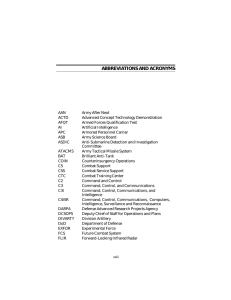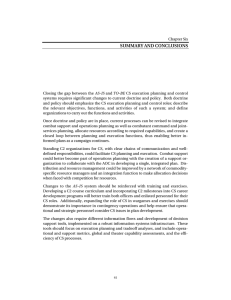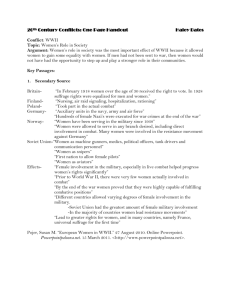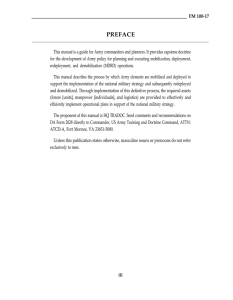Expeditionary Police Service Lieutenant Colonel Geoffrey Demarest U.S. Army
advertisement
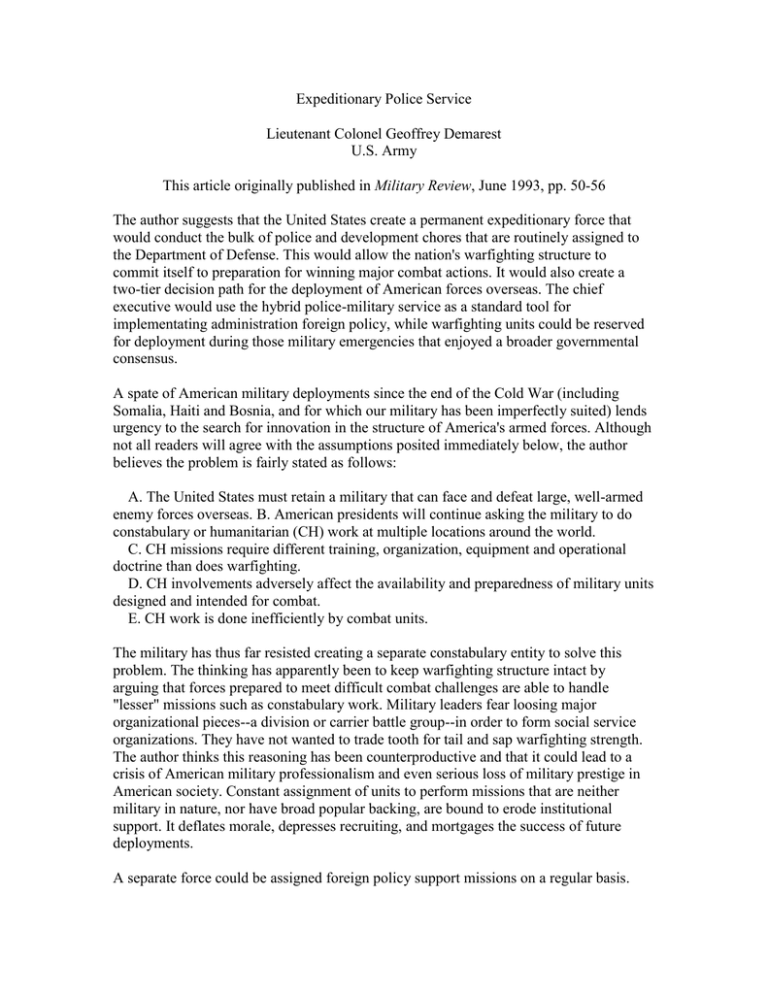
Expeditionary Police Service Lieutenant Colonel Geoffrey Demarest U.S. Army This article originally published in Military Review, June 1993, pp. 50-56 The author suggests that the United States create a permanent expeditionary force that would conduct the bulk of police and development chores that are routinely assigned to the Department of Defense. This would allow the nation's warfighting structure to commit itself to preparation for winning major combat actions. It would also create a two-tier decision path for the deployment of American forces overseas. The chief executive would use the hybrid police-military service as a standard tool for implementating administration foreign policy, while warfighting units could be reserved for deployment during those military emergencies that enjoyed a broader governmental consensus. A spate of American military deployments since the end of the Cold War (including Somalia, Haiti and Bosnia, and for which our military has been imperfectly suited) lends urgency to the search for innovation in the structure of America's armed forces. Although not all readers will agree with the assumptions posited immediately below, the author believes the problem is fairly stated as follows: A. The United States must retain a military that can face and defeat large, well-armed enemy forces overseas. B. American presidents will continue asking the military to do constabulary or humanitarian (CH) work at multiple locations around the world. C. CH missions require different training, organization, equipment and operational doctrine than does warfighting. D. CH involvements adversely affect the availability and preparedness of military units designed and intended for combat. E. CH work is done inefficiently by combat units. The military has thus far resisted creating a separate constabulary entity to solve this problem. The thinking has apparently been to keep warfighting structure intact by arguing that forces prepared to meet difficult combat challenges are able to handle "lesser" missions such as constabulary work. Military leaders fear loosing major organizational pieces--a division or carrier battle group--in order to form social service organizations. They have not wanted to trade tooth for tail and sap warfighting strength. The author thinks this reasoning has been counterproductive and that it could lead to a crisis of American military professionalism and even serious loss of military prestige in American society. Constant assignment of units to perform missions that are neither military in nature, nor have broad popular backing, are bound to erode institutional support. It deflates morale, depresses recruiting, and mortgages the success of future deployments. A separate force could be assigned foreign policy support missions on a regular basis. One possibility is a sub-service under the Department of the Army, with a relationship to the Army like that which the Marine Corps has to the Navy, but with a character more like that of the Coast Guard. A better option might be to place the service alongside the Coast Guard under the Department of Transportation. The benefits would be twofold at least. The existence of such a service would allow a more palpable, transparent distinction between foreign policy goals requiring some military expertise or physical support and national military emergencies requiring the application of enormous force. The practical difference could be founded on a legal differential between what was needed legislatively to deploy the constabulary force and what was needed to deploy the warfighting units. Strategic planning would be made more logical--avoiding confusions such as the promotion of a "two MRC strategy" in order to have enough forces available to conduct multiple peacekeeping assignments. The size of the warfighting structure could be measured against warfare threats, while the size of the constabulary force could be measured against other, political and foreign policy criteria. What follows, therefore, is an argument about why such a separate service makes sense from a military perspective, and about how a constabulary/humanitarian unit in a separate service might look. The "division" is the basic unit for discussion because it has intuitive appeal as a building block for ground forces and is most understandable by analogy. Denomination as a division suggests identity, permanence, and continuity, and it suggests that the constabulary or paramilitary service might be more than one division strong. The Army makes trade-offs in modern division design within parameters similar to those in tank design, the central variables being firepower, mobility and armor protection. Looking at the Army's division mix and considering the most recent experiment in division structure, the light infantry division (LID), it is evident that Army reasoning stayed within that same trade-off realm that delimited earlier division designs. The lighter unit supposedly could survive initial firepower challenges and reach a decisive point on the battlefield in time to eliminate geographic advantages that opposing forces might otherwise have. Sustainability could be de-emphasized if we could assume control of air and sea lines of communication. This is sound logic and has been successful as far as it goes. As long as the United States has the luxury of a well-identified enemy and a clear definition of military success based around the defeat of that enemy, the reasoning serves us. The American penchant in warfare continues to be our ability to apply superior firepower at the right place quickly. However, this tank design logic has failed us in some environments and will probably continue to do so in many situations subsumed under the sometimes unfortunate characterizations "low-intensity conflict (LIC)," "Operations Other Than War (OOTW)," or whatever arrives to replace these terms. Current division designs simply do not respond well to many mission challenges. Reasons for the mismatch of unit design and mission include the timing of the LID effort in relation to the development of Army doctrine. By the time the new LID structure had been designed, redesigned and tested, the Army had labored for a decade to produce a Low Intensity Conflict manual that did not receive enthusiastic acceptance. Also, strategic realities of the new world order, hard to see today, were harder to see before 1989. Inertia from a Fulda Gap orientation guided organizational reasoning. Now it is understandably difficult for the Army to revisit the line and block charts so soon after struggling to prove the LID concept. In fact, the very habit of creating organizations using the line and block diagram may be inappropriate to the new organizational task. On the other hand, the rapid and radical nature of world changes may help free DoD thinking and allow it to support something more appropriate to some of the extraneous demands of the new strategic environment. What we need is a basic unit structure for integrated accomplishment of the administration's most common overseas missions, but such an organization would have to be based on a new set of doctrinal criteria. These doctrinal precepts have to rest on something broader than current basic military philosophy. For instance, according to one central axiom upon which our military units are designed, everyone supports the combat soldier. Many of our military definitions and mission statements flow from this idea. Combat support (CS) units support combat units, the combat service support (CSS) units support everybody. It is an experience-proven relationship, but the time has come to break away from this starting point. As a more appropriate basic response to many mission statements, the individual soldier should provide combat support to noncombat efforts. Instead of thinking in terms of firepower and combat multipliers, constabulary officers have to think in terms of the need to more precisely define and locate any enemies, negate an enemy with the appropriate amount of force, and prepare populations to provide their own security. Rather than design a unit within the military trade-off triangle of mobility, firepower and armor protection, a new parameter must be established in which trade-offs are made among 1. the three traditional tank qualities (survivability, mobility, and firepower) put together, 2. ability to precisely define and locate the enemy (if one exists), 3. ability to engage populations to participate in their own security needs, 4. ability to use the appropriate amount of force needed in each circumstance, and 5. ability to provide or encourage physical and social infrastructure needed to release the unit from long term presence. When this new arrangement of design tradeoffs is accepted, support to the infantryman as a basic principle will give ground. Conversely, if this principle of support to the infantryman does give way, it is a change in organizational ethic that should not be wanted by the commander of a warfighting unit. The guiding concept for a constabulary (or utility) division is not that its units could reach an area of operations more quickly than a more heavily armed force; instead, the focus is on its long-term potential mission applicability. These missions would include what ground combat doctrine now calls rear area security, refugee relief, population control, occupation, counterinsurgency, counternarcotics, counterterrorism, humanitarian action, and so on. Creating a divisional structure in a separate service (rather than assigning sub-units to ad hoc task force headquarters) could promote unity of command as it relates to single point integration of intelligence and single-voice discipline regarding legal parameters for the use of force and intelligence collection. The furtherance of legal norms is a common philosophical denominator for all of today's overseas deployments. We expect political difficulties to arise over contradictions between the constant need to depict transparent legal forms and the occasional need to defeat organized, violent opposition via lethal force and covert intelligence collection. The unity of command provided by a division structure could also aid coordination of goals and policies in geographically separate areas of operation. It could satisfy the demand of oversight and control by civilian agencies, especially in intelligence collection and covert law enforcement. Equally important, it could ensure that civilian organizations, such as civilian police forces or aid organizations, were brought on line in a timely manner. In response to many missions, police and intelligence headquarters teams could be deployed overseas, and their planning and intelligence products replicated electronically at the division's home base. As teams are deployed or organized to address a specific situation, they would not leave behind a "brigade minus" --just a smaller brigade. In other words, there is no conceptual need to see the brigade as a unit requiring any fixed number of subunits to be considered at full strength. Any percentage of the brigades not deployed overseas would be able to conduct training or preparations for other likely missions. The division command would always be in position to view the interrelationships and costs of all deployments and set priorities for future preparations. National leaders could count on a single pipeline for control of varied involvements, for information and input of opinions. Likewise, the limits of the nation's ability to meet disparate overseas commitments in support of foreign diplomacy would make themselves apparent in the limit of resources available to the division or divisions. This would in itself aid in strategic decision making by making more evident the available resource base. A need for specialized doctrine and schooling presents another reason for the creation of a separate service structure. This need can be explained by reference to some understated advantages enjoyed by coalition forces in the recent Gulf War. There, the enemy was very clearly defined, the terrain was essentially unpopulated, and questions related to the human rights of persons encountered in the operational area had been effectively obviated before hostilities began. The Army's AirLand Battle (ALB) doctrine was suitable. But the geography in most mission zones will include large civilian populations, limiting applicability of AirLand Battle-type doctrine as employed in the Persian Gulf. Despite attempts to apply ALB-type concepts to low-intensity situations, much ALB-type doctrine is irrelevant to most overseas missions. Given a tactical problem in which the use of artillery might be proscribed by legal concerns about personal property damages, tort claims, ecological impact, bad publicity, and so on, education in traditional military operational techniques is, at best, inefficient. The existence of a basic unit freed from ALB-type doctrine would allow its service schools to consider and prepare new doctrine and training against the different set of unit requirements. Nothing here says that the Army should dump traditional military operatinal doctrine or that it should not remain the preponderant doctrinal preparation for the Army. The nation's ground forces may, however, have to read off more than one sheet of music. Currently, the weight of ALB-type thinking promises to keep the Army's training and education system from mastering concepts needed to respond to problems at the low end of the conflict spectrum. Aspects of Army employment at the low end of the violence range are already well understood and may be expressed by describing a unit structure capable of accomplishing missions in a low violence context. With that in mind, I offer the following design concept regarding distinctive details of a utility division's possible make up. A utility division might have five brigades— military police (MP), military intelligence (MI), engineer, aviation and combined arms combat (CAC), with a hospital and communications capability larger than a normal military division. The MPs need the ability to provide widespread police patrolling, and to interrogate and house prisoners, internees or refugees on a modularlv expandable scale. They must also have the ability to provide static defense for some installations, and a well-developed crowd control capability that includes a variety of non-lethal weapons options. They need an oversized criminal investigation capability as well. In short, the MP brigade would be the heart of the division's capability to provide stability and security. The MPs would be a first-line countersubversive tool. All constabulary/humanitarian efforts will need the support of an intelligence engine that continually seeks not only to define and precisely locate the enemy, but to identify the potential enemy, the half enemy, the apathetic, the indifferent, and so on. This engine will also have to create usable presentations about social and economic factors unrelated to any enemy per se. Legal ramifications will have to be considered a part of basic terrain intelligence. So we would weight the intelligence brigade toward human intelligence. This should include a capability to develop overt community intelligence support (hot lines and the like) and an organic ability to do extensive collection of social and economic (as well as limited military) intelligence. The engineer brigade needs the capability to construct paved roads, improve airfields, install potable water systems and build public structures. Roads and public infrastructure are in poor repair almost everywhere that US expeditionary police forces might be deployed. Even with no other specified civic action or psychological operations (PSYOP) effort, continuous construction is often sufficient to ensure public credibility and provide legitimacy for US presence. The engineer brigade is, in effect, the PSYOP and Civil Affairs unit of the division in that its work represents an unstated quid pro quo justifying foreign presence. In this respect, too, the engineer unit would have to slant its doctrine away from traditional projects and emphasize those that display a genuine concern for long range protection and improvement of the environment, especially the urban environment. Projects such as sanitary landfills and reforestation fall within these requirements, but so does military architecture designed to improve riot control and public security. A full aviation brigade would provide the division one of its key operational advantages. It needs sufficient lift to support remote civic action and humanitarian projects and to support the combat brigade if necessary. It would also be profitable to maintain several fixed-wing executive craft to provide liaison to multiple, distant deployments. Although the utility division is an essentially constabulary concept, it will need to be provided with organic firepower sufficient to not only defend itself, but to effectively tackle a range of low-level combat problems. An organic combined arms combat brigade should include a battalion of motorized infantry ("motorized" suggesting wheeled armored vehicles), a battalion of airborne/air assault infantry, a battery of artillery and an air cavalry squadron. The division would not need main battle tanks, but might need air defense assets if a regional missle threat existed. The essential capability of the utility division would not be provided by its combat strength, which summed could generate about one-fifth to one-fourth the firepower of the Army's light divisions. However, in comparison with most national armies, a constabulary division could still have considerable punch. The commander of the division would more likely be a general with a police or intelligence background than an infantry or armor one. His staff would require an especially heavy judge advocate general (JAG) office and a very large public affairs office (PAO). The principal staff group should consist of the usual personnel (G1), intelligence (G2), operations and plans (G3) and logistics (G4), plus the JAG, PAO and the communications-electronics officer. The JAG would continue to be present on the commander's personal staff. There should be no PSYOP or Civil Affairs units or staffs denominated as such, and no officer in the division should be designated as either the PSYOP or civil affairs officer. PSYOP and Civil Affairs activities are essential to the utility division's mission planning and should be the understood purview of the commander and his principal staff, not considered an add-on or specialty. That is to say, why should there be a Civil Affairs or PSYOP officer if civil affairs and PSYOP is at the heart of the mission of the entire service and every deployment? The G2 and G3 staffs should be 100-percent integrated, with officers, noncommissioned officers and civilians moving from one type of function to the other. The G2 staff should include a small intelligence audit section and civilian agency liaison. Briefing support and written reporting should come directly from the intelligence brigade in coordination with other intelligence information providers, especially the criminal investigation unit. The division should integrate test beds for new equipment, especially in the areas of computerization, nonlethal weaponry, land mine control, sniper defense, and illegal substance interdiction. The very fact of creating a division structure based on new premises allows design experimentation that would otherwise be almost impossible in a combat division, given the weight of the old ways. Tables of organization and equipment should also include a radically increased requirement for language training and have sufficient manpower levels to maintain a fixed percentage of assigned personnel continuously detached for language training. Task organization should not be tied to any concept of direct or indirect support. The division can incorporate each functional element that can be used profitably based on incremental advantage of the participation. There need be no default formula for the number of engineers that would be assigned to a particular size of police force, for example. All the above suggestions assume that the combat brigade would be called upon in the nature of a super SWAT team to provide muscle in exceptional situations. It would fill most of the gap between routine police activities and military combat situations. If an opposing force has sufficient strength to continually challenge the division's police formula of operations, then it should be assumed that the utility division units would have to be replaced, protected by a standard combat unit, or withdrawn. In other words, the police approach of the utility division is not a denial of the wisdom of Air Land Battletype doctrine. In the face of an extensive, organized, armed enemy capable of maneuver and massed firepower, the utility division formula is inherently inadequate. As stated earlier, however, we need to set aside part of our total force to allow it to work under a different set of constraints. As presented, the utility division may appear to be little more than a downsized and retailored version of one of the Army's corps support commands. But the utility division, like its parent Expeditionary Police Service, would be dedicated to a different mission and would work under different rules than those guiding the warfighting military. It would be the organizational answer to questions about how DoD might best go about doing constabulary and humanitarian work. And while the utility division is not intended to be a support unit, it could be efficient as a supporting element further up the conflict spectrum. The cost to total warfighting strength in the event of a major war would not be as great as it might look. The utility divisions could contribute to rear area protection and urban combat missions that gobble up warfighting strength anyway. Meanwhile, a radical departure from current division structures would also provide the testing vehicle for answers to possibly unseen combat problems.
